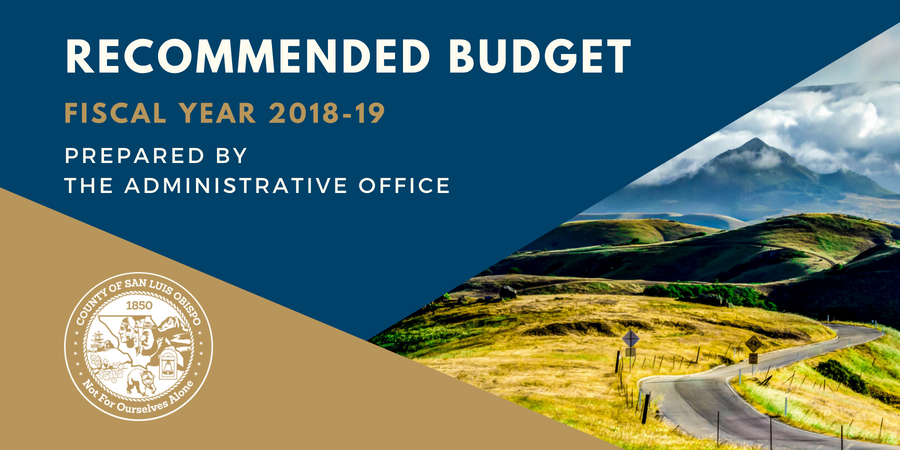
6 Things to Know About County of SLO’s Recommended Budget
Author: Administrative Office
Date: 5/29/2018 9:41 AM
Next fiscal year’s recommended budget has officially been introduced to the Board of Supervisors. Here's what you need to know.
Next fiscal year’s recommended budget has officially been introduced to the Board of Supervisors and will be up for discussion during the public budget hearings which will be held June 11-13. Recommended spending levels for next fiscal year (July 1, 2018 through June 30, 2019) are $622.2 million (1.78% more than the current year), with the General Fund budget recommended at $521.7 million (2.27% more than the current year).
But what does this all mean? Here are 6 important things to know:
- The budget in its current form is staff’s recommended spending plan. The FY 2018-19 budget document currently available to the public is CAO Wade Horton’s recommended spending plan based on input from a variety of sources (see #3 below). Ultimately, the Board of Supervisors decides how to allocate public resources for the County of San Luis Obispo. The public is invited to participate in the upcoming budget hearing (June 11 - 13), when staff will present details about the recommendations and the Board will discuss and decide how to allocate resources. Public comment is welcome.
- The budget is balanced. As required by the State Budget Act, the County’s recommended budget for next fiscal year is balanced. While there was a projected deficit during early phases of the budgeting process, County staff successfully closed that gap using a number of the County’s longstanding budget balancing strategies and approaches. Despite increased expenses in some areas, the recommended budget was balanced by decreasing roads funding from the General Fund by $1 million (from $8.1 million to $7.1 million), funding a portion of capital and maintenance expense ($2.1 million) and a one-time $400,000 contribution to the SLO Art Museum with reserves (the County’s version of a savings account), and trimming departments’ requested expenses by $1.9 million.
- Many had a hand in developing the budget. Everything included in next fiscal year’s recommended budget is based on a collaborative process involving the public, the Board of Supervisors, County staff, key stakeholders from the local nonprofit community, and volunteers serving on the County’s various advisory boards and commissions. While preparing the budget, staff also considered expected changes at the state and federal level of government (see #4 below). The result reflects the County’s organizational values of integrity, collaboration, professionalism, accountability, and responsiveness.
- The budget can still be significantly impacted by a variety of factors outside of the County’s control. Certain things can impact the County’s budget next year. Any increase or decreases in taxes can impact the County’s overall revenue. Likewise, unforeseen local issues or expenses could impact next year’s budget as they arise mid-year. Certainly, issues at the state and federal levels of government could impact the County’s spending plans. For example, the County could receive less money from state or federal sources depending on the actions of voters as well as state and federal lawmakers. The following are examples of issues that could impact the County’s budget next year:
- The state unwound the Coordinated Care Initiative and prior In-Home Supportive Services (IHSS) maintenance of effort, which means that the state shifted additional costs to counties for these programs.
- Continuum of Care Reform changes placement and treatment options for foster care youth, which could impact the County’s finances.
- The repeal of Senate Bill 1 (SB 1) would significantly impact the County’s’ revenue for road repair and infrastructure projects. The County is currently set to receive $6.5 million next year from the state through SB 1, which will help maintain local roads and bridges. An effort to repeal SB 1 is underway for the June 5 Primary Election and, if it is successful, the County would not receive revenue stream. The County would have to significantly increase the amount it’s paying to meet its road condition targets.
- Diablo Canyon is closing. The County is a major player when it comes to preparing the community for the closure of Diablo Canyon Power Plant. The County’s expenses will be impacted in the years ahead as the County continues in its efforts to plan for the closure.
- Employee salaries and benefits make up the largest part of the County’s expenses (more than 60% of all expenses). The County is the largest employer in the region, with over 2,800 employees. Employee salary and benefit expenses include employee wages, the amount that the County pays for employee pensions, County contributions to employee health care and life insurance, and a variety of other employee benefits such as social security taxes, workers’ compensation payments, and unemployment insurance payments. These costs are driven by the number of County employees, negotiated labor agreements, and the cost of employee benefits. With this in mind, the recommended budget includes a staff increase of only 8.75 full-time equivalent positions compared to the current year’s adopted levels. When developing a spending plan, the County must strike a balance between financial security, programs and services, and employee salaries and benefits.
- County staff is recommending $7.7 million for the jail inmate health care budget. The County provides jail services to all the jurisdictions in San Luis Obispo County, including all of the incorporated cities. The recommended $7.7 million budget for jail inmate health care is approximately $2.3 million more in General Fund support compared to the current fiscal year’s adopted amount. The increase is recommended, per Board direction in the current fiscal year, to augment jail health care services and for the Chief Medical Officer added under the Sheriff’s Office in March 2018. These expenses include both medical and mental health care services for inmates at the County Jail. In prior years, medical care expenses for inmates were included in the Law Enforcement Medical Care budget and mental health care expenses were included in Behavioral Health Department budget. Now they are all in one place. So, some funds are being shifted from the Behavioral Health budget. Additional recommended funding is intended to further improve communication and inmate care at County Jail.
